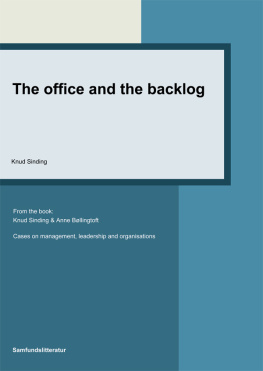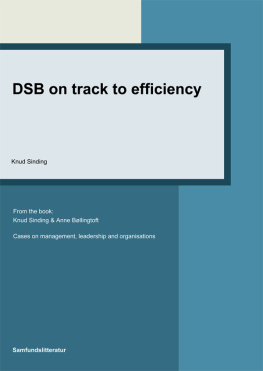Sinding - The office and the backlog
Here you can read online Sinding - The office and the backlog full text of the book (entire story) in english for free. Download pdf and epub, get meaning, cover and reviews about this ebook. City: Samfundslitteratur, year: 2013, publisher: Samfundlitteratur;, Samfundslitteratur, genre: Home and family. Description of the work, (preface) as well as reviews are available. Best literature library LitArk.com created for fans of good reading and offers a wide selection of genres:
Romance novel
Science fiction
Adventure
Detective
Science
History
Home and family
Prose
Art
Politics
Computer
Non-fiction
Religion
Business
Children
Humor
Choose a favorite category and find really read worthwhile books. Enjoy immersion in the world of imagination, feel the emotions of the characters or learn something new for yourself, make an fascinating discovery.
- Book:The office and the backlog
- Author:
- Publisher:Samfundlitteratur;, Samfundslitteratur
- Genre:
- Year:2013
- City:Samfundslitteratur
- Rating:3 / 5
- Favourites:Add to favourites
- Your mark:
- 60
- 1
- 2
- 3
- 4
- 5
The office and the backlog: summary, description and annotation
We offer to read an annotation, description, summary or preface (depends on what the author of the book "The office and the backlog" wrote himself). If you haven't found the necessary information about the book — write in the comments, we will try to find it.
The office and the backlog — read online for free the complete book (whole text) full work
Below is the text of the book, divided by pages. System saving the place of the last page read, allows you to conveniently read the book "The office and the backlog" online for free, without having to search again every time where you left off. Put a bookmark, and you can go to the page where you finished reading at any time.
Font size:
Interval:
Bookmark:
Knud Sinding
The office and the backlog

Knud Sinding
The office and the backlog
From the book:
Knud Sinding and Anne Bllingtoft
Cases on Management, Leadership and Organisations, 1st edition 2012, chapter 7
1st e-book chapter 2013
Samfundslitteratur 2012
Cover design: Klahr|Graphic Design
Typeset: SL grafik, Frederiksberg
E-book production: Rosendahls BookPartnerMedia
ISBN: 978-87-593-9538-7
Samfundslitteratur
Rosenoerns All 9
DK-1970 Frederiksberg C
Denmark
Tlf: + 45 38 15 38 80
Fax: + 45 35 35 78 22
www.samfundslitteratur.dk
All rights reserved.
No part of this publication may be reproduced or used in any form or by any means graphic, electronic or mechanical including photocopying, recording, taping or information storage or retrieval system without permission in writing from the publisher.
CHAPTER 7
THE OFFICE AND THE BACKLOG
Motivation is considered difficult and complicated. Some managers believe in direct monetary incentives, and these work just fine you get what you pay for. However, if the product is complicated, motivation built on monetary incentives will almost always fail. However, there are simple alternatives, no matter what the context is.
Under constant pressure
Employees at the offices of the Board of Compensation have been looking to the future with something approaching optimism. A little over a year ago, the mood was much worse. Cases were piling up and dissatisfied applicants went to the press or to politicians, or both. In parliament, after every single mention of the slow handling of cases in the press, questions were asked of the minister, or the minister was called before the Parliamentary Committee. Each time, the minister promised to do more to deal with the backlog and to allocate more resources. Out of the limelight, a new manager for the Compensation Boards Secretariat was appointed. All in all, the only thing employees did not fear was firings. Their jobs were secure as long as the backlog existed.
The Board is one of many such boards that handle the administration of a specific area in Danish legislation, where it is important to separate case decisions from the rest of the vast public bureaucracy, and important that the separation is clearly visible to those who are in contact with the Board and its decisions. The name of the Compensation Board is derived from its mission, which is to compensate people who have suffered an injury without being responsible for it. It is important that users or applicants get their cases processed swiftly. Because the issues deal with peoples lives, health and mobility it is also of great importance that the Board make the right decisions. The Board has existed for more than 15 years and has, in recent years, had a fairly stable number of cases.
For practical reasons, cases are received by another office, which constitutes the injured persons first contact with public authorities in connection with the injury. This other office sends the case to be handled by the Board. It is also this office, which handles the payment of the amounts awarded in a case. The Boards independence from the national government can be seen from its composition. The chairman is a High Court judge; one of the two additional members is a lawyer while the second member has a background as head of appeals in the National Social Services Appeals Board. The Board receives all funds for administrative costs and compensations from the ministry.
In practice, the members of the board only decide the most complicated cases themselves. The majority of cases are handled by caseworkers in the Boards secretariat. Here, the incoming cases are compiled and all decisions are made and communicated from here, either with the message that a payment is on its way or a letter of rejection.
Staffing in the Boards secretariat isnt extensive. There is a manager who is a lawyer, seven legal caseworkers, one or two additional junior legal caseworkers working part-time (typically one day per week), a few clerical workers and around four student assistants. The legal caseworkers are usually recent graduates or new recruits to the ministry area (ministry with authorities and other institutions), and the Board is their first job after employment. These employees will typically leave the Board after about two years to fill a completely different position within the ministry. The part-time caseworkers are typically also younger employees with the rest of their workload placed in the ministrys central management. Clerical staff is often comprised of seasoned workers that have typically been employed by the Board for many years.
The Board receives about 3000-4000 new cases every year, and this amount has remained relatively constant for several years. Each year, about 50 million Danish Kroner are awarded in lump sum benefits. The Boards operational budget is tight, partly due to the savings requirements of the annual budgets.
Period of change
This account of the new Boards internal affairs begins just over a year ago, when a new manager of the secretariat took office. The position as manager was relatively clear, the tasks were well defined and therefore the Board was widely seen as a good place to test an aspiring managers abilities. The manager was responsible for daily operations, case management, management of employees, hiring and dismissal, etc. This particular manager, however, was different from most other managers the secretariat had had.
Normal practice was that the manager was appointed from among applicants that came from the ministrys central administration. Much against the wishes of senior managers in the ministry, the new manager of the secretariat came from a different area outside the ministrys normal career system. When the minister and head of administration visited the Board, the latters handshake with the new manager of the secretariat was accompanied by the words So, you are that woman, implying: the person that was foisted upon us against our will.
All cases must pass the managers desk. Many of these are routine cases, which can be decided immediately. Other cases can be more complicated and must be handled by the Board itself. In a few cases, an applicant may be so dissatisfied with a refusal that they will take legal action against the Board to overturn its decision.
When the new manager of the secretariat took office in the middle of the year, the secretariat had accumulated a large backlog of cases. It could take seven months from the time an application was received before processing even began. Once processing did start, it didnt take long before a decision was made, so the issue was the length of time a case waited in a pile. The backlog, and with that the time applicants had to wait, had for several years been on the rise from 700 unprocessed cases four years earlier to 1355 cases two years earlier. At the end of the previous year, probably related to the adding of additional resources, there was a slight drop to 1168 unprocessed cases.
Under the new secretariat manager, the Boards way of measuring how much work was done changed to a manual counting of the case piles size, since the antiquated computer system couldnt do this type of statistic. In March last year, the Board moved to new and cheaper premises with brighter offices, more space and better facilities overall. The rooms were newly renovated and in connection with the move, most of the sad, old furniture, in the style of what is also known as the 1970s prison service look, was discarded. Instead, a portion of what was saved on rent went towards new furnishing including new desks with elevation functions and, most importantly, new IT equipment.
Next pageFont size:
Interval:
Bookmark:
Similar books «The office and the backlog»
Look at similar books to The office and the backlog. We have selected literature similar in name and meaning in the hope of providing readers with more options to find new, interesting, not yet read works.
Discussion, reviews of the book The office and the backlog and just readers' own opinions. Leave your comments, write what you think about the work, its meaning or the main characters. Specify what exactly you liked and what you didn't like, and why you think so.













